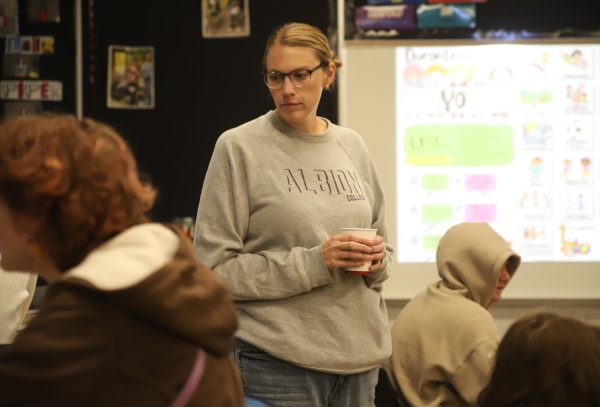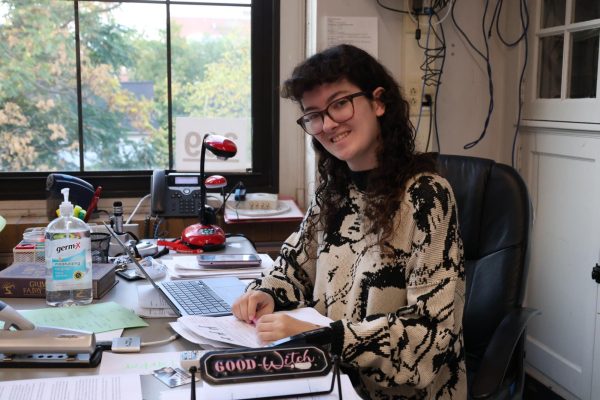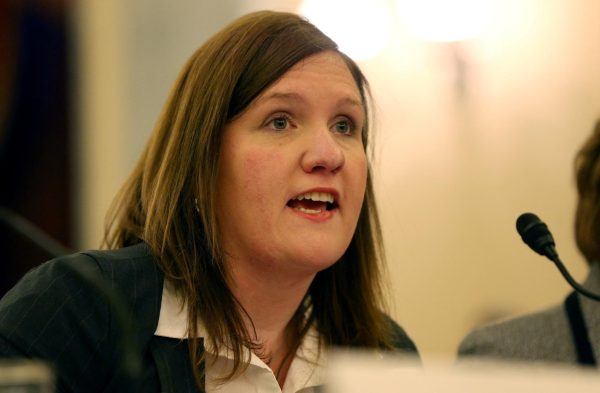Future of Food
As the planet’s population increases and temperatures climb, climate change will transform our food industry.
‘Why would anyone not be vegan?’ Seven Steiner asked themself after an eye-opening conversation with their camp counselor about her choice to be vegan and the impact of a non-vegan diet. They talked about the negative impacts of climate change and animal cruelty, as well as her positive feelings about not contributing to factory farming, given that the majority of carbon emissions are produced by animals and meat transportation. After their session at camp ended, Steiner knew what changes they wanted to make in their own life.
“When I got back from summer camp, it was pretty easy for me to make the switch [to veganism] because my parents used to be vegan,” Steiner said. “They helped me with things like figuring out how to get enough nutrients and protein.”
To Steiner, being vegan requires a change of mindset — a set of choices that are dedicated to sustainability and taking action against animal cruelty. Steiner believes that there is a common misconception that every vegan is mad at those who don’t follow a plant-based diet.
“While I do think it would be beneficial for the planet and for people if more people went vegan, I’m not gonna get mad at people for the choices that they make with their own life,” Steiner said.
That being said, Steiner hopes that there will be a point in the future where people are more open-minded to being vegan. And even if not everyone will adopt a vegan lifestyle, there will be no factory farming and livestock can be raised humanely, reducing animal cruelty and damage to the environment.
Since the start of the year, 38 million tons of meat have already been consumed on a global scale. This number is only going to increase. The United Nations estimates that the population in 2050 will be 9.7 billion people. And the estimated amount of meat to be consumed in 2050 will be 570 million tons.
But what are the environmental costs of producing meat? Raising livestock makes up 11% of the United States’ total greenhouse gas (GHG) emissions — gases in the Earth’s atmosphere which trap heat. Cows emit methane, the second most abundant GHG after carbon dioxide and makes up 20% percent of global emissions. Nitrous oxide —another GHG which is 300 times more potent than carbon dioxide— is a result from the installation of agricultural fertilizers, organic and synthetic. Additionally, the production of beef is the largest contributor to deforestation, as forests are destroyed to expand pasture land. On average, it takes 2,000 gallons of water to produce a single pound of beef — a much larger footprint compared to other livestock.
As shown above, our diets affect the world we live in, but there are ways to address this. For Jonathan Thomas-Palmer, CHS physics teacher, who has been vegan for three years, turning around his diet and lifestyle was out of concern for the Earth, but also for the benefits to his own health and appreciation for food.
“Cheese used to be something that I put on everything,” Thomas-Palmer said. “And I’ve realized that basically, I was just flavoring everything with cheese. I wasn’t actually tasting the food I was eating,” Thomas-Palmer said.
Thomas-Palmer is not the only vegan in his family — in fact, his entire family is vegan. It was an abrupt switch to a plant-based diet: his wife was instrumental in that choice, doing the majority of the research behind why being vegan is better for the environment.
“It has to do with the amount of energy it takes to make non-vegan foods,” Thomas-Palmer said. “And that’s terrible for the planet.”
Given that his whole family follows a plant-based diet, it is convenient both financially and organizationally, as his family only needs to create one meal which caters to everyone. But being vegan can be very difficult, which is especially evident when traveling.
“Everything has meat and dairy in it,” Thomas-Palmer said. “It is just amazing how many places we just can’t go [to] because they don’t have any options.”
But, with experience, Thomas-Palmer has learned how to adapt and plan appropriately. When traveling, he and his wife have identified specific vegan restaurants and it has become a ritual which his family looks forward to. Thomas-Palmer admits that if you eat meat and dairy, these situations are easier because “that’s just the society we live in.”
To Thomas-Palmer, the future of veganism is complicated: he thinks that there is a stigma surrounding veganism and a meat dependent diet. That isn’t true, according to Thomas-Palmer.
“You can get the proteins you need from getting a wide variety of foods which are plant based,” Thomas-Palmer said. “There are a lot of meat alternatives now too.”
From his point of view, people are close-minded when it comes to a plant-based diet, which stems from tradition — food encompasses family and cultural traditions — and lack of knowledge about the benefits of veganism.
“[It is important to educate] people about the effects of their own diet and how the vegan diet will have a less [damaging] effect on [the planet],” Thomas-Palmer said.
To mitigate climate change effects and ensure food security, food production and diets need to change, according to Maureen Devlin, an associate professor of anthropology at the University of Michigan, has been studying different human diets and how certain environmental factors and preferences such as climate, physical activity, location and dietary differences can impact the nutrition of humans. When looking at the future of nutrition, there are three directions that the path of future nutrition will look like, according to Devlin.
Today, many of the foods we eat are ultra-processed foods, says Devlin. As defined by the National Institute of Health, ultra-processed foods are foods which were once whole foods but transformed into substances which undergo chemical modifications and have additives to have a longer shelf life in addition to being ready to consume and are highly profitable.
“Many [foods] have been processed much more [now] than has been true for most of our evolutionary history,” Devlin said.
Devlin claims that there is evidence and research which states that ultra-processed foods are not necessarily beneficial for us. She emphasizes, however, that it isn’t a matter of what foods are ‘good’ and ‘bad,’ but looking at the bigger picture.
“Overall, the percentage of the foods that most of us eat on a daily basis that have already been processed in some way compared to [those] that are in their original state has been increasing over time,” Devlin said.
The second idea that Devlin believes comes as no surprise is that climate change is — and will continue to — deeply impact food availability which will disproportionately affect those who already have the least access to food. This is based on models where data shows how climate change is making its mark on animals’ behavior patterns.
“So we’re already starting to see some of those hints that the way that plants and animals behave and reproduce is changing,” Devlin said.
Examples of this include fish and birds: climate change is forcibly displacing them as they migrate to places where there are conditions vital for them to survive, such as bodies of water with cooler temperatures or an earlier migration. Crops and their growing seasons are also being deeply affected as the temperature changes and there is an unnerving problem particularly near the equator. In Devlin’s opinion, warmer temperatures are considered a double-edged sword when it comes to crop production. Corn, as stated by Devlin, is a C4 plant which uses a specific photosynthesis mechanism to avoid photorespiration, the evolution of CO2 during photosynthesis. C4 plants best thrive in hotter and drier conditions, like near the equator. Wheat, on the other hand, is a C3 plant, a plant that converts CO2 into an organic compound by using its C3 carbon fixation pathway. These plants like cooler and wetter climates and as the Earth warms, C3 plants will suffer in those conditions. But CO2, the primary GHG emitted by human activity, helps plants grow, Devlin says.
“So you might think, is having more CO2 in the atmosphere a bad thing because plants will grow better?” Devlin said.
But this ‘benefit’ does not outweigh the much more negative impacts, such as prioritizing how much water is available to prevent droughts as well as the fact that pests prosper in warmer climates.
Lastly, Devlin believes that there are interesting and innovative directions in the food industry, like insects, a protein eaten around the globe and different continents. Today, insects can come in different forms like high protein flours. Globally, animal agriculture emissions are rooted in the conversion of forests into croplands, creating animal feed and methane coming from cows and sheep — plant-based meats and tofu require no cropland necessary. A collaboration between the University of Oxford and a research group in Switzerland found that tofu emitted only two kilograms of greenhouse gas emissions whereas beef emitted 50 kilograms, producing 25 times more greenhouse gas emissions. A study done by researchers at Oxford and Rikkyo University found that insects use up to 50 to 90% less land and produce 1,000 to 2,700 GHG emissions per kilogram compared to livestock. And as stated in this study and by Devlin, insects are not a new food and in fact, insects can provide 10 to 35 grams of protein per 100 grams, compared to 17 to 20 grams of meat.
“People have always eaten insects and other primates, like chimpanzees, gorillas and orangutans, all eat insects,” Devlin said. “In certain societies, people sort of grossed out or disgusted by the idea of eating insects, but they’re a great source of protein.”
In the other direction, there are plant-based meats, such as the Impossible Burger and Beyond Burger, which use 72% to 99% less water than meat, as stated by the Good Food Institute. But there are even lab-grown meats. The process of making lab grown meats involves taking a small amount of muscle tissue or cells of a living animal and then attempting to grow it in the lab. The idea behind these two options —plant-based meat and lab grown meat — is that it provides an alternative for those who want to eat something that looks and tastes like a burger, but doesn’t harm any animals and uses much less water. And while lab grown meats are currently not on the market, Devlin believes that the idea is to make these options less expensive as time goes on.
“Things like the Impossible Burger are still more expensive than beef, but they’re less expensive than they were originally,” Devlin said. “And they’re much more readily available than they were originally.”
But even if the costs go down and there are several different alternatives, not everyone will go on a plant based diet, reasons spanning from dietary preferences to nutritional needs.
“In general, when we try to force people to do something, it often doesn’t go well,” Devlin said. “If you think about things like when New York tried to tax sodas or [when] people proposed taxes on junk food, none of those have gone well. The voters have repealed them.”
Additionally, Devlin states that several anthropologists have pointed out that present bias, one of the psychological biases, is a contributing factor to why some people have fixed mindsets: humans are biased to focusing on the present moment rather than contemplating about their actions and its impact on the future.
“That is the reason that people don’t put money in their 401Ks, it’s the reason that people put off doing things,” Devlin said. “Even if we know intellectually that in a couple of decades, we may be sorry, it’s harder for us to change our behavior now.”
And if people decide to take action and adopt a plant based diet, Devlin emphasizes that it’s crucial to be attentive and ensure that they’re eating a variety of different kinds of foods, especially for children, who need nutrients while they grow.
While Devlin believes that there are several benefits to eating more plant based foods, she also believes that in our society, people want to make their own food choices and that is seen as a cultural value.
“We can try to encourage or discourage certain things,” Devlin said. “When I was a child, people were allowed to smoke indoors, in restaurants, on airplanes. And that meant everyone was exposed to that secondhand smoke.”
Despite secondhand smoke being damaging to those who were exposed, Devlin states it is harder to implement that same expectation for dietary decisions as it is more difficult to make the argument that they affect others directly, as well as indirectly.
“On a societal level, certain foods are associated with a higher risk of cancer or a higher risk of other health problems,” Devlin said. “There might be sort of broader societal effects of eating those foods, but it’s less of that direct effect on the other individual that provided the rationale for taking smoking out of indoor spaces.”
To Devlin, maintaining the idea that everyone gets the right to choose what is best for them and their lifestyle is valuable, but being aware of all lifestyles that can greatly benefit one’s health and the planet’s condition is just as important.
Another aspect Devlin mentions is that people find it difficult to believe there is a problem if they are not actively watching it happen before their eyes which evokes changes in their habits.
“Public opinion might change more readily once people are actually seeing the effects for themselves,” Devlin said. “I think it’s really hard for many people to believe that there’s a problem that will happen in the future, if there’s no evidence of it right now. I think that that is a general problem — It’s not just about climate change. Humans, in general, want to see the evidence that something is a problem.”
Still, Devlin remains optimistic about the future. According to Devlin, there are societal efforts to be made, such as consuming less meat, diversifying our diets and learning how eating more plants is beneficial and can reduce the effects of climate change. She believes that forcing dietary changes will not help the climate crisis and encouraging people to be aware of the facts and research done can cause a big shift towards a greener society.












